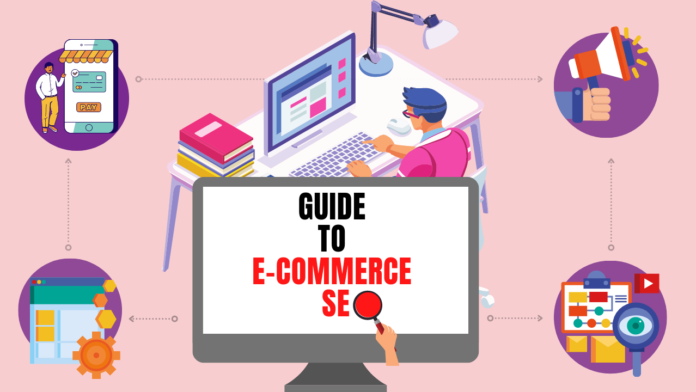E-Commerce websites are all the rage of the ever-evolving Business industry. It is only natural that business and technology go together in today’s extremely high-tech world.
E-Commerce websites utilize this concept to their maximum potential. On-page SEO is of utmost importance if you hope to increase your website’s traffic and sales. You can expand your business using the SEO strategy for E-commerce. After extensive research, we have created an E-Commerce SEO checklist for your convenience.
Getting started might seem daunting at first but these basic tips will guide you sufficiently well for you to get started. Remember, it’s crucial to stay up-to-date in the SEO Industry in order to stay relevant and visible.
What is SEO for E-Commerce?
When you search for a product online, Google recommends you many online stores where you can buy it. Since everyone wants fast results, people generally only click on the results displayed on the first search result. A good SEO website is designed with quality content, best SEO practices, and optimization to rank high on search engines.
Therefore, we can say that e-commerce SEO is the process by which you can rank better and increase the visibility of your e-commerce store on the search engine result page.
Is SEO important for E-Commerce?
Even if you know what is SEO and what is eCommerce, you might still be confused about what is eCommerce SEO, and how to do SEO for eCommerce websites.
SEO E-Commerce is the holy grail to making your online business grow. If implemented correctly, the right customers will land on your website and make meaningful purchases. It provides free, repeating, and high-converting traffic.
With so much competition, your business needs to appear on the top in order to increase your visibility and reach your target audience. Of course, it is possible to get traffic by using advertisements and paid searches. But you need to pay for these services and if AdBlockers and AdBlindness come into the picture, the outcome is still largely determined by your SEO practices.
How e-commerce sites improve SEO?
By now you must understand what is an e-commerce website. E-commerce websites are useful to gain a deeper understanding of your customers, for instance, what demographics your general audience is from (locations, age groups, leads).
They also help you recognize what’s not working and make suitable adjustments. For example, cart abandonment and high bounce rate.
How can I improve my eCommerce website?
You can improve your eCommerce website by optimizing your headlines, product descriptions, metadata, internal link structure, and user interface for a fast search and quality user experience. It’s helpful to have customized pages for every product to drive higher traffic from search engines.
It is advisable to follow the beginner’s fool-proof strategy:
- Start Prioritizing pages: Focus on the pages which get maximum views and the highest traffic. Since people are already interested in this content, you should strive not to just maintain their intrigue but increase it and ultimately have a loyal audience.
If you have a new product launch that you want to highlight or a flagship product, you should also focus on them. - Address the fundamentals: SEO has varied requirements that must be carefully addressed to make the best use of it. Work on including high-ranked keywords, add metadata, ensure to name your images correctly, add alternate attributes for images, and incorporate related keywords.
- Analyze the competition: Nobody is going to buy your product if a similar website is offering it at a lower price and better quality. You don’t necessarily have to lower your product prices. You just need to ensure that your product is the best in the market so people are willing to pay for it. Building trust with the customers is important.
Your eCommerce SEO strategy should be planned to outsmart the competition. Look at your top competitors and keep an eye out for their new launches, changes, campaigns, etc. Find ways to make yours better.
- Follow through with CRO: Conversion rate optimization (CRO) should follow SEO. We’ll talk about that more later on.
Now, that you know how to improve your eCommerce website, let’s look at ways to make your website the best.
E-commerce SEO best practices
1. Don’t neglect Keyword research
- Understanding the buyer’s intent will give you an idea about what keywords should you be using on your website.
- It’s no good if you use a lot of high-ranking keywords but end up pulling people who are not interested in buying the products.
- This can be done by analyzing metrics like paid ads, knowledge graph results, and organic listings, searching high-bid keywords on google ads and reviewing analytics regularly.
- You can use various tools to perform rank tracking, find backlink data and get site audit reports. Rank tracking is helpful when finding high-ranked keywords to include on your website. Backlink data gives an insight into customer needs and interests.
- It can open opportunities for collaborations with brands/businesses that your customers are interested in. And lastly, just like you need a regular medical check-up, your website needs a regular site audit to find and configure any issues that might be affecting the performance.
2. Optimize Product Pages to Improve Ranking
Your product page is the most important part of your E-Commerce website, and therefore, it is essential that it is eye-catching, well-designed, and optimized to reach a high conversion rate.
Here are a few ways in which you can maximize the impact of your product descriptions.
- Use multiple, high-quality, unique images that give an appropriate portrayal of your goods.
- Include keywords and captions with alt tags for all images.
- Include detailed, keyword-rich descriptions
- Adding calls to action (CTAs) like “check availability” or “add to cart“
- Include testimonials and reviews to build consumer’s trust.
3. Long-Tail Keywords
As the name suggests, A long-tail keyword is long a term, generally made of 3-5 words. These words and specific and have lower search volume but still meet the criteria for targeting your intentional demographic.
Being a better match for what the user wants to search, these keywords convert relatively and give higher traffic.
While no one should hesitate from using long-tail keywords, they are especially useful for competitive niches and newer sites by increasing conversion rates and ranking new sites.
4. Use Schema Mark-ups to Help Google and Users
HTML tags that provide extra information about the web page content. These tags are known as Schema markups. Schema markups produce rich snippets which help improve your website SEO. Snippets refer to small descriptions about products, reviews, availability, etc that are visible on search engines. These provide a way for more information about specific items in the search results.
5. Use a Simple URL Structure
A simple URL structure is easier to remember and makes the website seem more reliable. Other than the aesthetics, it also improves SEO e-commerce to some extent by providing more relevant data for search engines. It is a good practice to make URLs as readable and understandable as possible.
6. Create unique high-quality Content
A lot of E-Commerce websites are so busy optimizing their products that they tend to neglect quality content. Make it a habit to post regular content for Ecommerce website. Regular, high-quality content attracts organic traffic, increases your customers trust, boosts your website rankings, and cements your reputation as an expert in your domain.
The types of content you can focus on are as follows:
- Writing “how-to” articles and answering FAQs
- Talking about new product launches and trending news
- Including user-generated content (UGC)
- Sharing testimonials and launches
- Creating video demonstrations and hosting webinars, lives, etc.
7. Avoid Duplicate Pages and Content
To stand out in the E-Commerce business, you need to build your unique identity. Using duplicate/copied content/descriptions is counterproductive. This not only gives your website a bad reputation but also affects SEO negatively.
If you do take inspiration from other websites, make sure to:
- Use canonical tags on every page that might have duplicates (pages with similar titles, pages that share an identical URL, etc.)
- Add a suffix to the URL
- Use different product images and descriptions
- Add unique keywords on other pages
8. Make Your Site User Friendly
Looks might not be all that matters but they still have a huge impact. Make sure your website has a good User Interface. It should be aesthetically pleasing, easy to navigate, and impressionable.
A few tips about good UX are:
- Ensuring Ads don’t interfere with the user’s view of content.
- Make your mobile-friendly and fast-loading
- Your website should be clutter-free and easy to navigate.
- Include multiple Calls-To-Actions, so customers are not lost.
9. Link Building for E-Commerce
Google uses links to determine your site’s credibility. Backlinks can dominate how your website ranks for keywords on the search engine result page. Link building is a great eCommerce SEO strategy.
A few ways to do this are:
- Creating internal backlinks
- Writing guest posts and getting backlinks to established websites
- Using social media ads
- Sharing content on social media
- Writing blog comments
- Creating infographics and sharing them online
- Issuing whitepapers and case studies
10. Create a Sitemap
Sometimes, you are in a hurry and don’t have the time to peruse through a very lengthy article. You might just be interested in a particular section, and it is tedious to find it in a big body of text.
Thus, it is a good practice to include a Sitemap for your website which gives the user’s an overall visual representation of your site’s structure. It should include information and details of all of the pages on your website. Remember to include subcategories, product descriptions, and any other relevant content within those sections. Giving users ease of access will definitely enhance your eCommerce website SEO.
11. Combine SEO with CRO
CRO or Conversion Rate Optimization is a vast topic that we will cover in another article. It is mentioned here because combining SEO with CRO is the best SEO Ecommerce Strategy. To purchase your products, people first need to find your website and then make a sale.
Therefore, you need to optimize your website for SEO in order to bring in potential customers. But it doesn’t end here, you need to optimize your page to increase the conversion rate also. If people just visit your website to window-shop, it isn’t going to help your business grow. Find a good balance of both and watch your sales rocket!
Conclusion
We are aware that these methods can be tedious and time-consuming. While it may be enticing to use shortcuts, a lot of paid backlinks violate Google’s policy and harm your site’s credibility.
Stay consistent, and your efforts will ultimately yield results! SEO E-Commerce is an ever-growing industry with so much to learn every day. The best way to get an advantage in a competitive market is to keep up with the regular updates about SEO.







